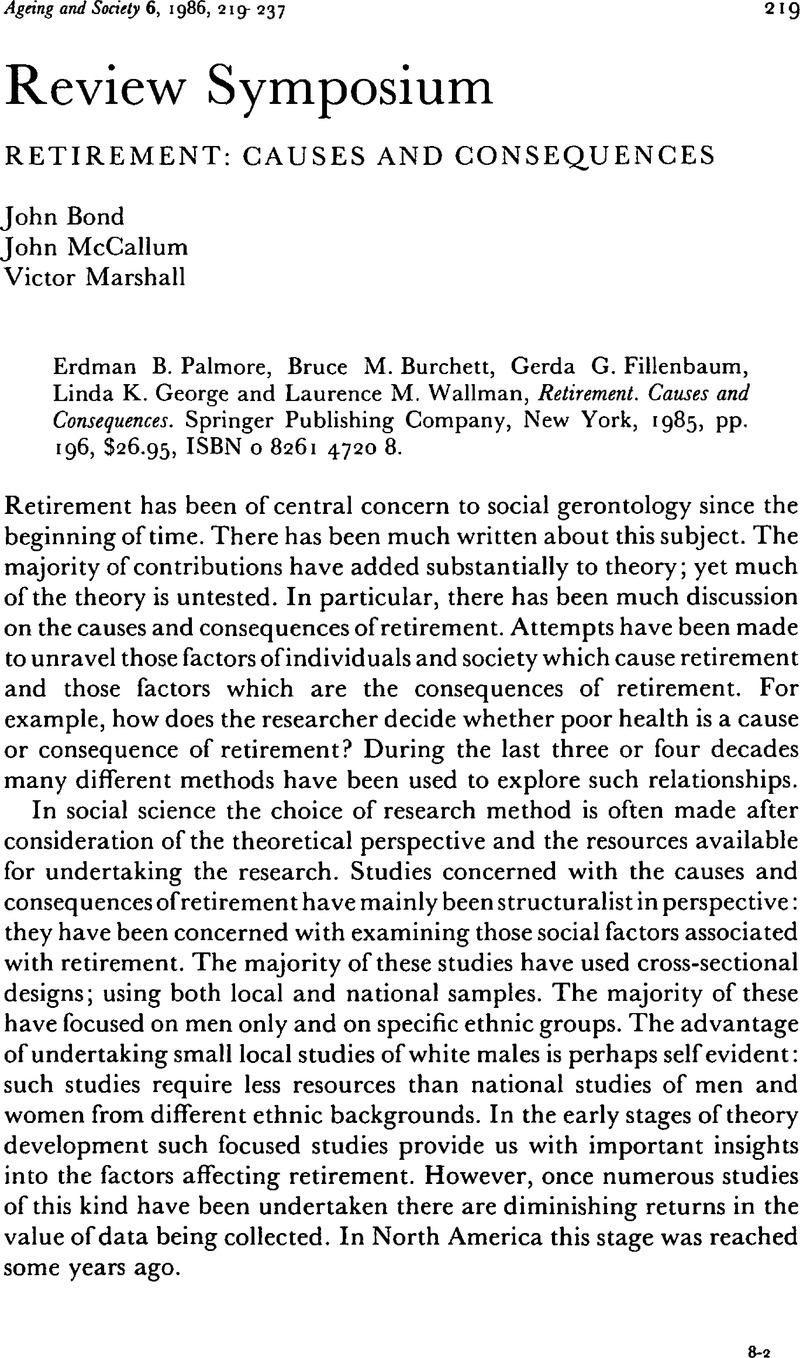Article contents
Retirement: Causes and Consequences
Published online by Cambridge University Press: 14 November 2008
Abstract

- Type
- Review Symposium
- Information
- Copyright
- Copyright © Cambridge University Press 1986
References
NOTES
1 Murray, J., Subjective retirement. Social Security Bulletin, 42 (1979), 1–7.Google ScholarPubMed
2 Parnes, H., Work and Retirement. Massachusetts Institute of Technology Press, Cambridge, Mass., 1981.Google Scholar
3 Morgan, J. and Duncan, G. (eds), Five Thousand American Families, vol. VIII. Institute of Social Research, Ann Arbor, Mich., 1980.Google Scholar
4 Simpson, I. and McKinney, J. (eds), Social Aspects of Aging. Duke University Press, Durham, N.C., 1966.Google Scholar
5 Palmore, E. (ed). Normal Aging, vol. II. Duke University Press, Durham, N.C., 1974.Google Scholar
6 Atchley, R., ‘The process of retirement: the female experience’, in Szinovacz, M. (ed.) Women's Retirement. Sage Publications, Beverley Hills, Ca., 1982.Google Scholar
7 Barfield, R. E. and Morgan, J. N., Early Retirement: The Decision and the Experience. Institute of Social Research, Ann Arbor, Mich., 1969.Google Scholar
8 Atchley, R., The Sociology of Retirement. Schenkman, New York, 1976Google Scholar; Palmore, E.Why do people retire? Aging and Human Development, 2 (1971), 269–283CrossRefGoogle Scholar; Sheppard, H., ‘Work and retirement’, in Binstock, R. H. and Shanas, E. (eds), Handbook of Aging and the Social Sciences. Van Nostrand Reinhold, New York, 1976.Google Scholar
9 Burkhauser, R., The pension acceptance decision of older workers. Journal of Political Economy, 14 (1979), 63–75Google Scholar; Parnes, H., op. cit.Google Scholar; Streib, G. F. and Schneider, C. J., Retirement in American Society: Impact and Process. Cornell University Press. Ithaca, N.Y., 1971.Google Scholar
10 Barfield, R. E. and Morgan, J. N., op. cit.Google Scholar; Barfield, R. and Morgan, J., Trends in satisfaction with retirement. The Gerontologist, 18 (1978), 19–23CrossRefGoogle ScholarPubMed; Morgan, J., ‘Retirement in prospect and retrospect’Google Scholar, in Morgan, J. and Duncan, G., op. cit.Google Scholar;, Parnes, H. and Nestel, G., ‘The retirement experience’Google Scholar, in Parnes, H., op. cit.Google Scholar
11 Atchley, R., op. cit., 1976Google Scholar; Bengston, V., ‘Differences between subsamples in level of present role activity’Google Scholar, in Havinghurst, B., Neugarten, B., Munnichs, J. and Thomae, H. (eds.), Adjustment to Retirement. Van Gorkum, The Netherlands, 1969Google Scholar; Bixby, L., Kolodurbetz, W., Lauriat, P. and Murray, J., Demographic and Economic Characteristics of the Aged: 1968 Social Security Survey.Google Scholar Social Security Administration Office of Research and Statistics, Washington, D.C., 1975; Cottrell, F. and Atchley, R., Women in Retirement: A Preliminary Report. Scripps Foundation, Oxford, Ohio, 1969Google Scholar; Epstein, L. and Murray, J., The Aged Population of the U.S. Government Printing Office, Washington, D.C., 1967Google Scholar; Havinghurst, B. et al. , op. cit.Google Scholar; Nadelson, T., A survey of the literature on the adjustment of the aged to retirement. Journal of Geriatric Psychiatry, 3 (1969), 3–20Google Scholar; Shanas, E. ‘Adjustment to retirement’, in Carp, F. (ed.), Retirement. Behavioural Publications, New York, 1972Google Scholar; Shanas, E., Townsend, P., Wedderburn, D., Friis, H., Milhoj, P. and Stehouwer, H., Older People in Three Industrial Societies. Atherton, New York, 1968Google Scholar; Simpson, I. and McKinney, J., op. cit.Google Scholar; Thompson, G., Work versus leisure roles. Journal of Gerontology, 28 (1973), 339–344CrossRefGoogle ScholarPubMed; Thompson, G., Work experience and income of the population aged 60 and over. Social Security Bulletin, 37 (1974), 3–20.Google Scholar
12 Haynes, S., McMichael, A. and Tyroler, H., Survival after early and normal retirement. Journal of Gerontology, 33 (1978), 269–279CrossRefGoogle ScholarPubMed; Morgan, J., ‘Antecedents and consequences of retirement’, in Hill, M., Hill, O. and Morgan, J. (eds.), Five Thousand American Families, vol. ix. Institute for Social Research, Ann Arbor, Mich., 1981Google Scholar; Parnes, H., op. cit.Google Scholar; Streib, G. F. and Schneider, C. J., op. cit.Google Scholar
13 George, L., Role Transitions in Later Life. Brooks/Cole, Monterey, Ca., 1980Google Scholar; George, L. and Bearon, L., Quality of Life in Older Persons: Meaning and Measurement. Human Sciences Press, New York, 1980.Google Scholar
14 Simpson, I. and McKinney, J., op. cit.Google Scholar; Atchley, R., Retirement and work orientation. Gerontologist, II (1971), 29–32CrossRefGoogle Scholar; Cottrell, F. and Atchley, R., op. cit.Google Scholar
15 Streib, G. F. and Schneider, C. J., op. cit.Google Scholar; George, L. and Maddox, G., Subjective adaptation to loss of the work role: a longitudinal study. Journal of Gerontology, 32, (1977), 356–362.CrossRefGoogle ScholarPubMed
16 Morgan, J., op. cit.Google Scholar; Motley, D., Availability of retired persons for work. Social Security Bulletin, 41 (1978), 18–28Google Scholar; Palmore, E., op. cit., 1971Google Scholar; Parnes, H., op. cit.Google Scholar; Streib, G. F. and Schneider, C. J., op. cit.Google Scholar
17 Kimmel, D., Price, K. and Walker, J., Retirement choice and retirement satisfaction. Journal of Gerontology, 33 (1978), 575–585CrossRefGoogle ScholarPubMed; Peretti, P. and Wilson, C., Voluntary and involuntary retirement of aged males and their effect on emotional satisfaction, usefulness, self-image, emotional stability, and interpersonal relationships. International Journal of Aging and Human Development, 6 (1975), 131–138.CrossRefGoogle Scholar
18 Fillenbaum, G. G. and Maddox, G. L., Work after retirement: an investigation into some psychologically relevant variables. Gerontologist, 14 (1974), 418–424CrossRefGoogle ScholarPubMed; Kell, D. and Patton, C. V., Reaction to induced early retirement. The Gerontologist, 18 (1978), 173–179CrossRefGoogle ScholarPubMed; Barfield, R. E. and Morgan, J. N. et al. , 1969Google Scholar; Stagner, R., Propensity to work: an important variable in retiree behaviour. Aging and Work, 2 (1979), 161–172.Google Scholar
1 Atchley, Robert C., The Sociology of Retirement, Schenkman Publishing Co., Cambridge, Mass., 1976, p. 5.Google Scholar
2 Palmore, Erdman B.The Honorable Elders. A Cross-cultural Analysis of Ageing in Japan, Duke University Press, Durham, 1975, p. 12.Google Scholar
- 4
- Cited by


